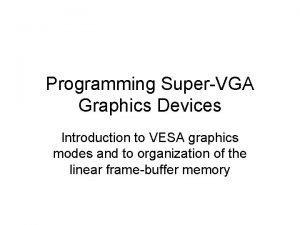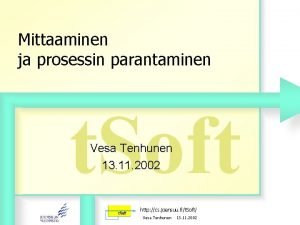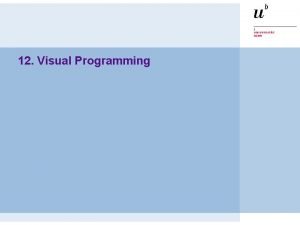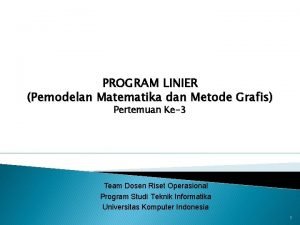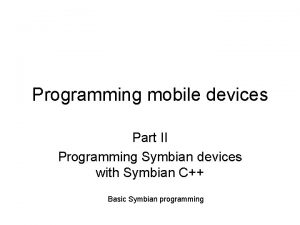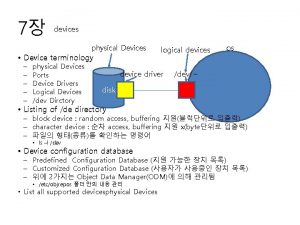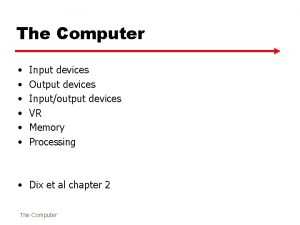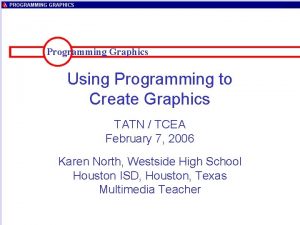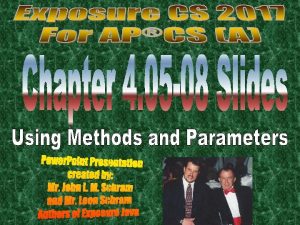Programming SuperVGA Graphics Devices Introduction to VESA graphics
























- Slides: 24

Programming Super-VGA Graphics Devices Introduction to VESA graphics modes and to organization of the linear frame-buffer memory

Motivation • The impetus for high-quality PC graphics was an early incentive for developing the 32 -bit Intel x 86 processor, since graphics images with realistic color and animation requires efficient access to a much larger memory-segment than can be addressed with the original 20 -bit real-mode scheme

Raster Display Technology The graphics screen is a two-dimensional array of picture elements (‘pixels’) These pixels are redrawn sequentially, left-to-right, by rows from top to bottom

Special “dual-ported” memory VRAM CRT CPU 128 -MB of VRAM 4096 -MB of RAM

Screen-resolution 640 480 640 -by-480 = 307200 pixels (i. e. , picture-elements)

Early ‘planar’ memory 7 6 5 4 3 2 1 0 Each cpu byte-address controlled 8 adjacent pixels in 4 parallel color-planes 640 -by-480 times 4 -planes, divided by 8 bits-per-byte = 38400 byte-addresses

Greater picture fidelity 640 1280 960 480 1280 -by-960 = 1228800 pixels (i. e. , picture-elements) times 4 bytes-per-pixel = 614400 bytes of vram

Typical Chipset Layout CPU Central Processing Unit Graphics Controller AC Audio Controller Multimedia Controller MCH Memory Controller Hub (Northbridge) NIC Network Interface Controller ICH I/O Controller Hub (Southbridge) Firmware Hub Timer DRAM Dynamic Random Access Memory HDC Hard Disk Controller Keyboard Mouse Clock

PCI Configuration Space A non-volatile parameter-storage area for each PCI device-function PCI Configuration Space Header (16 doublewords – fixed format) 64 doublewords PCI Configuration Space Body (48 doublewords – variable format)

PCI Configuration Header 16 doublewords 31 0 Status Register BIST Header Type Command Register Latency Timer Cache Line Size 31 0 Device ID Vendor ID Class Code Class/Sub. Class/Prog. IF Revision ID Dwords 1 - 0 3 - 2 Base Address 1 Base Address 0 5 - 4 Base Address 3 Base Address 2 7 - 6 Base Address 5 Base Address 4 9 - 8 Card. Bus CIS Pointer 11 - 10 Subsystem Device ID Subsystem Vendor ID reserved capabilities pointer Expansion ROM Base Address 13 - 12 Maximum Minimum Interrupt Latency Grant Pin Interrupt Line reserved 15 - 14

Interface to PCI Configuration Space Address Port (32 -bits) 31 CONFADD ( 0 x 0 CF 8) E N 23 reserved 16 15 bus (8 -bits) 11 10 device (5 -bits) 8 7 function (3 -bits) doubleword (6 -bits) 2 0 00 Enable Configuration Space Mapping (1=yes, 0=no) PCI Configuration Space Data Port (32 -bits) 31 CONFDAT ( 0 x 0 CFC) 0

Reading PCI Configuration Data • Step one: Output the desired longword’s address (bus, device, function, and dword) with bit 31 set to 1 (to enable access) to the Configuration-Space Address-Port • Step two: Read the designated data from the Configuration-Space Data-Port: # read the PCI Header-Type field (byte 2 of dword 3) for bus=0, device=0, function=0 movl $0 x 8000000 C, %eax # setup address in EAX movw $0 x 0 CF 8, %dx # setup port-number in DX outl %eax, %dx # output address to port mov inl shr movb $0 x 0 CFC, %dx, %eax $16, %eax %al, header_type # setup port-number in DX # input configuration longword # shift word 2 into AL register # store Header Type in variable

Graphics programs • What a graphics program must do is put appropriate bit-patterns into the correct locations in the VRAM, so that the CRT will show an array of colored dots which in some way is meaningful to the human eye • So the programmer must understand what the CRT will do with the contents of VRAM

How ‘truecolor’ works 24 longword alpha 16 8 red green R G 0 blue B pixel The intensity of each color-component within a pixel is an 8 -bit value

Intel uses “little-endian” order VRAM 0 1 2 B G R 3 4 5 6 B G R Video Screen 7 8 9 10 B G R

Vendor incompatibilities • Several competing vendors manufacture graphics controllers for the PC market • They’re based in various parts of the world (e. g. , United States, Canada, Taiwan, etc. ) • Their hardware designs are not identical • The VESA (Video Electronics Standards Association) organization was created to create a standardized firmware interface

VBE 3. 0 • The VESA BIOS Extensions document is accessible on our CS 630 course website • It implements services in a manner similar to the ROM-BIOS routines we’ve used in our previous boot-time applications (e. g. , via software interrupt-0 x 10) • We’ve created a demo-program (named ‘vesademo. s’) illustrating VESA’s use

Typical ‘program-structure’ Usual steps within a graphics application: – – Initialize video system hardware Display some graphical imagery Wait for a termination condition Restore original hardware state

Hardware Initialization • The SVGA system has over 300 registers which must be individually reprogrammed • It would take us many months to learn how they all work to support a graphics mode • For now, we just ‘reuse’ vendor-supplied routines, built into the SVGA firmware • They usually support quite a few different screen-resolutions and color-depths

Physical Memory Layout Graphics frame-buffer Base-Address is dynamically assigned by firmware at power-on CPU address space (4 GB) our code/data 0 x 0001000

VESA function 1 • Obtains a block of parameter-values for the desired graphics display-mode: – Scanline-width (in bytes) – Horizontal resolution (in pixels) – Vertical resolution (in pixels) – Pixel-size (in bits-per-pixel) – Frame-buffer’s physical address

VESA function 2 • Reprograms all the graphics controller’s internal device registers for the selected VESA-standard display-mode

In-class exercise #1 • Can you reprogram the colors used in our ‘vesademo. s’ application to use another border-color and another annulus-color? 31……. . . 24 23…… 16 15…. . 8 7 ……… 0 ALPHA RED GREEN BLUE

In-class exercise #2 • Can you modify our demo-program so as to use a standard VESA graphics mode that has a higher screen-resolution? – Mode 0 x 0115 was for 800 -by-600, 32 bpp – Mode 0 x 0118 is for 1024 -by-768, 32 bpp
 Supervga
Supervga Vesa joutsen
Vesa joutsen Vesa korpelainen
Vesa korpelainen Vesa sarmia
Vesa sarmia Vesa kosonen
Vesa kosonen Vesa haapala
Vesa haapala Vesa tenhunen
Vesa tenhunen Ranuras vesa
Ranuras vesa Vesa lappalainen
Vesa lappalainen Vesa virtanen turku
Vesa virtanen turku Antti-jussi lakanen
Antti-jussi lakanen Fpds lunch menu
Fpds lunch menu C kortista luopuminen
C kortista luopuminen Kyrönpellon ampumarata vuorot
Kyrönpellon ampumarata vuorot Vesa tiitinen
Vesa tiitinen Vesa martikkala
Vesa martikkala Perbedaan linear programming dan integer programming
Perbedaan linear programming dan integer programming Greedy vs dynamic programming
Greedy vs dynamic programming System programming vs application programming
System programming vs application programming Integer programming vs linear programming
Integer programming vs linear programming Definisi linear
Definisi linear Realitykit example
Realitykit example Programming raster display system in computer graphics
Programming raster display system in computer graphics Math for graphics programming
Math for graphics programming Programming graphics
Programming graphics
